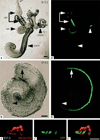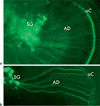Cellular targeting for cochlear gene therapy
- PMID: 19494575
- PMCID: PMC4379510
- DOI: 10.1159/000218210
Cellular targeting for cochlear gene therapy
Abstract
Gene therapy has considerable potential for the treatment of disorders of the inner ear. Many forms of inherited hearing loss have now been linked to specific locations in the genome, and for many of these the genes and specific mutations involved have been identified. This information provides the basis for therapy based on genetic approaches. However, a major obstacle to gene therapy is the targeting of therapy to the cells and the times that are required. The inner ear is a very complex organ, involving dozens of cell types that must function in a coordinated manner to result in the formation of the ear, and in hearing. Mutations that result in hearing loss can affect virtually any of these cells. Moreover, the genes involved are active during particular times, some for only brief periods of time. In order to be effective, gene therapy must be delivered to the appropriate cells, and at the appropriate times. In many cases, it must also be restricted to these cells and times. This requires methods with which to target gene therapy in space and time. Cell-specific gene promoters offer the opportunity to direct gene therapy to a desired cell type. Moreover, conditional promoters allow gene expression to be turned off and on at desired times. Theoretically, these technologies offer a mechanism by which to deliver gene therapy to any cell, at any given time. This chapter will examine the potential for such targeting to deliver gene therapy to the inner ear in a precisely controlled manner.
Copyright (c) 2009 S. Karger AG, Basel.
Figures





Similar articles
-
Transcriptional regulation by Barhl1 and Brn-3c in organ-of-Corti-derived cell lines.Brain Res Mol Brain Res. 2005 Nov 30;141(2):174-80. doi: 10.1016/j.molbrainres.2005.09.007. Epub 2005 Oct 13. Brain Res Mol Brain Res. 2005. PMID: 16226339
-
Brn-3c (POU4F3) regulates BDNF and NT-3 promoter activity.Biochem Biophys Res Commun. 2004 Nov 5;324(1):372-81. doi: 10.1016/j.bbrc.2004.09.074. Biochem Biophys Res Commun. 2004. PMID: 15465029
-
Age-Related Hearing Loss Is Dominated by Damage to Inner Ear Sensory Cells, Not the Cellular Battery That Powers Them.J Neurosci. 2020 Aug 12;40(33):6357-6366. doi: 10.1523/JNEUROSCI.0937-20.2020. Epub 2020 Jul 20. J Neurosci. 2020. PMID: 32690619 Free PMC article.
-
The regulation of gene expression in hair cells.Hear Res. 2015 Nov;329:33-40. doi: 10.1016/j.heares.2014.12.013. Epub 2015 Jan 21. Hear Res. 2015. PMID: 25616095 Free PMC article. Review.
-
Mammalian auditory hair cell regeneration/repair and protection: a review and future directions.Ear Nose Throat J. 1998 Apr;77(4):276, 280, 282-5. Ear Nose Throat J. 1998. PMID: 9581394 Review.
Cited by
-
Adeno-associated virus-mediated gene delivery into the scala media of the normal and deafened adult mouse ear.Gene Ther. 2011 Jun;18(6):569-78. doi: 10.1038/gt.2010.175. Epub 2011 Jan 6. Gene Ther. 2011. PMID: 21209625 Free PMC article.
-
Neurod1 suppresses hair cell differentiation in ear ganglia and regulates hair cell subtype development in the cochlea.PLoS One. 2010 Jul 22;5(7):e11661. doi: 10.1371/journal.pone.0011661. PLoS One. 2010. PMID: 20661473 Free PMC article.
-
Surgical method for virally mediated gene delivery to the mouse inner ear through the round window membrane.J Vis Exp. 2015 Mar 16;(97):52187. doi: 10.3791/52187. J Vis Exp. 2015. PMID: 25867531 Free PMC article.
-
Nuclear entry of hyperbranched polylysine nanoparticles into cochlear cells.Int J Nanomedicine. 2011;6:535-46. doi: 10.2147/IJN.S16973. Epub 2011 Mar 14. Int J Nanomedicine. 2011. PMID: 21468356 Free PMC article.
-
Cochlear Gene Therapy.Cold Spring Harb Perspect Med. 2019 Sep 3;9(9):a033191. doi: 10.1101/cshperspect.a033191. Cold Spring Harb Perspect Med. 2019. PMID: 30323014 Free PMC article. Review.
References
-
- Bazan-Peregrino M, Seymour LW, Harris AL. Gene therapy targeting to tumor endothelium. Cancer Gene Ther. 2007;14:117–127. - PubMed
-
- Friedmann T. Gene Therapy: Fact and Fiction in Biology’s New Approaches to Disease. Woodbury: CSHL Press; 1994.
-
- Lodish H, Berk A, Zipursky S, Lawrence S, Matsudaira P, Baltimore D, Darnell J, editors. Molecular Cell Biology. New York: Freeman; 1999.
-
- Verdone L, Agricola E, Caserta M, Di Mauro E. Histone acetylation in gene regulation. Brief Funct Genomic Proteomic. 2006;5:209–221. - PubMed
Publication types
MeSH terms
Substances
Grants and funding
LinkOut - more resources
Full Text Sources
Other Literature Sources

